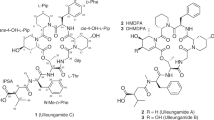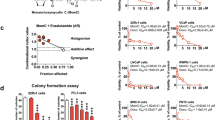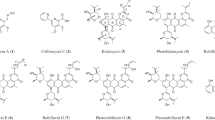Abstract
Mitogen-activated protein kinase (MAPK) pathways that direct cellular responses are involved in various biological processes; the RAS-RAF-MEK-ERK pathway is one of the most important MAPK pathways. It is frequently activated in human malignant tumors such as melanomas, thyroid tumors and colorectal carcinomas. Therefore, targeting this pathway has been considered an attractive strategy for new anticancer drugs. In particular, MEK is a promising target because it is a kinase that directly phosphorylates ERK. We performed a screening to discover new MEK inhibitors, and found a guanine derivative produced by Streptomyces sp. MK63-43F2. This guanine derivative was identified to be 2-amino-4-methoxy-5-cyanopyrrolo[2,3-d]pyrimidine (1) through spectroscopic analysis. Compound 1 inhibited MEK1 kinase activity in an ATP-dependent manner and suppressed the phosphorylation of ERK in cancer cells and cell proliferation. Therefore, 1 might be a potent lead compound for new MEK inhibitors.
Similar content being viewed by others
Main
Mitogen-activated protein kinases (MAPKs) are a family of serine/threonine protein kinases that are involved in multiple pathways of various biological processes such as cell proliferation, survival, differentiation and motility. The RAS–RAF–MEK–ERK pathway is one of the most important MAPK pathways. Aberrant activation of the RAS–RAF–MEK–ERK pathway leads to uncontrolled cell growth. In human malignant tumors, this pathway is often hyperactivated through aberrant activation of the receptor tyrosine kinases or gain-of-function mutations in the RAS or RAF genes.1, 2 Activating RAS mutations occur in ~30% of all human cancers.3 RAF consists of three family members, ARAF, BRAF and CRAF, and oncogenic mutations of the BRAF gene such as BRAFV600E are detected in ~66% of human melanomas, 69% of papillary thyroid tumors and a lower proportion of colorectal carcinomas.4, 5, 6 Therefore, members of the RAS–RAF–MEK–ERK pathway have been considered as attractive targets for new anticancer drugs.
Vemurafenib (PLX4032) and dabrafenib (GSK2118436), potent inhibitors of oncogenic BRAF kinase activity, have been approved for the treatment of BRAF-mutant melanoma.7, 8, 9 Although BRAF inhibitors conferred significant survival benefits in patients with melanoma, most of those treated with vemurafenib develop resistance to it within 2–18 months.10 Several mechanisms of acquired resistance to RAF inhibitors have been proposed, the majority of which lead to the reactivation of the MAPK pathway in the presence of BRAF inhibition.11, 12 Accordingly, targeting MEK1/2 is a promising strategy for cancer treatment with activating the RAS–RAF–MEK–ERK pathway, because inhibition of MEK1/2 can abrogate all upstream signals for ERK activation.13 For example, trametinib (GSK1120212/JTP-74057), a specific and potent MEK1/2 inhibitor, has been used for the treatment of patients with BRAFV600E mutation metastatic melanomas.14, 15
Microbial secondary metabolites have unlimited chemical diversity and are often used to treat human diseases. Therefore, they are considered to be a hopeful resource in drug discovery. Umezawa found various types of bioactive compounds in microbial metabolites. In particular, many enzyme inhibitors such as the epidermal growth factor receptor (EGFR) kinase inhibitor erbstatin have been isolated.16, 17, 18 We have also screened microbial metabolites to discover new MEK kinase inhibitors and found 2-amino-4-methoxy-5-cyanopyrrolo[2,3-d]pyrimidine (1), produced by Streptomyces sp. MK63-43F2, as a MEK inhibitor (Figure 1a). Compound 1 inhibits MEK1 kinase activity and suppresses cell proliferation. In this study, we identified the producing strain and determined the structure and biological activity of 1.
2-amino-5-cyano-4-methoxypyrrolo[2,3-d]pyrimidine (1) produced by Streptomyces sp. MK63-43F2. (a) Structure of 1. (b) Scanning electron micrograph of strain MK63-43F2 after grown on ISP medium No. 3 for 14 days at 27 °C. Scale bars=1 μm. (c) Structure of dapiramicin B (2). (d) Correlations of 1 obtained by 1H–1H COSY, 1H–13C HMBC and 1H–15N HMBC.
The producing strain MK63-43F2 was isolated from a soil sample collected in Japan. Strain MK63-43F2 formed well-branched substrate mycelia and straight-to-flexuous aerial mycelia (Figure 1b). Mature spore chains consisted of 16–30 or more spores, which were cylindrical with a hairy-to-spiny surface and were 0.5 × 0.7–0.8 × 1.5 μm in size. The substrate mycelia grown on oatmeal agar (ISP medium No. 3) were light brown to brown, whereas the aerial mycelia were light brownish gray. The stereoisomer of diaminopimelic acid in the cell wall was determined to be that of the ll-form. The partial 16S ribosomal RNA gene sequence (1488 bp) was determined and submitted to the GenBank/EMBL/DDBJ database under accession number LC269163. This gene sequence showed high similarity with that of the genus Streptomyces such as Streptomyces yeochonensis NBRC 100782T (1458/1482 bp, T: type strain, 98.3%) and Streptomyces ferralitis SFOp68T (1445/1470 bp, 98.2%). These phenotypic and genotypic data suggested that this strain belongs to genus Streptomyces. Therefore, the strain was designated as Streptomyces sp. MK63-43F2.
A slant culture of Streptomyces sp. MK63-43F2 was inoculated into a 500 ml baffled Erlenmeyer flask containing 110 ml of a seed medium consisting of 2.0% galactose, 2.0% dextrin, 1.0% Bacto Soytone (BD, Franklin Lakes, NJ, USA), 0.5% corn steep liquor (byproduct of the corn wet-milling process, Kougo Starch, Chiba, Japan), 0.2% ammonium sulfate and 0.2% CaCO3, pH 7.4. The culture was incubated at 30 °C for 9 days on a rotary shaker at 220 r.p.m. Portions of 7 ml of this seed culture were transferred into each of K1 14 flasks containing 15 g of pressed barley in 25 ml of deionized water as a solid production medium. The culture was incubated statically at 30 °C for 14 days.
The whole fermentation medium was extracted with 560 ml of ethanol, and then the residue was further extracted with 560 ml of 70% aqueous ethanol. The aqueous ethanol extract was evaporated to remove the ethanol and the remaining residue was partitioned between ethyl acetate and water (adjusted to pH 8.0 with 6 n NaOH). The ethyl acetate layer contained compound 1 and the aqueous layer contained dapiramicin B (2).19, 20, 21 First, the ethyl acetate layer was concentrated in vacuo to give a crude material. The crude material (0.44 g) was applied on an adsorbent column (MCI GEL CHP20P, Mitsubishi Chemical, Tokyo, Japan) and eluted with methanol. Furthermore, the fractions containing 1 were concentrated in vacuo and the resulting residue was chromatographed using a gel filtration column (Sephadex LH-20, GE Healthcare, Chicago, IL, USA) with methanol to obtain 2.5 mg of pure 1. Next, the aqueous layer containing 2 was concentrated in vacuo to give a crude material. The resulting crude material was extracted with methanol and the extract was concentrated in vacuo. The residue was applied on a silica gel column (Merck, Darmstadt, Germany) and eluted with a mixture of ethyl acetate and methanol (9:1) to obtain 41 mg of pure 2. Because spectroscopic data of 2 were identical to those of dapiramicin B, 2 was identified as dapiramicin B (Figure 1c).22
Physicochemical properties of 1 are summarized in Supplementary Table S1. Compound 1 was obtained as a colorless amorphous solid, was soluble in dimethylsulfoxide, slightly soluble in methanol and insoluble in water. The IR spectrum of 1 showed a characteristic absorption from a nitrile group at 2223 cm−1. The molecular formula of 1 was revealed to be C8H7N5O based on high-resolution ESI-MS and NMR data. The 1H and 13C NMR spectroscopic data of 1 are shown in Supplementary Table S2. Analysis of the 13C NMR spectrum of 1 revealed the presence of eight carbon atoms, categorized as one methoxy, one sp2 methine, five sp2 quaternary and one nitrile carbon atoms. The structure of 1 was primarily elucidated using 1H–1H COSY and HMBC experiments (Figure 1d). In the 1H–1H COSY spectrum, the sp2 methine proton (δH 7.80) at C-6 was correlated with a secondary amine proton (δH 12.06) at N-7. In the 1H–13C HMBC spectrum, the methine proton at C-6 furthermore correlated with three sp2 quaternary carbons at C-5 (δC 82.4), C-4a (δC 95.4) and C-7a (δC 154.9), and a nitrile carbon (δC 116.1) at C-5. The amine proton at N-7 correlated with two sp2 quaternary carbons at C-5 and C-4a. These correlations suggested the presence of a tri-substituted pyrrole ring possessing a nitrile group. In the 1H–15N HMBC spectrum, the primary amino protons (δH 6.44) at C-2 correlated with the two nitrogen atoms at N-1 and N-3. In the 1H–13C HMBC spectrum, the primary amino protons at C-2 also correlated with the three sp2 quaternary carbons (δC 160.7, 162.7 and 154.9) at C-2, C-4 and C-7a. Furthermore, the methoxy protons (δH 3.95) correlated with the C-4 carbon. These correlations suggested the presence of a 2-amino-4-methoxypyrimidine moiety. Taken together, the chemical structure that satisfied all NMR data for 1 was revealed to be 2-amino-5-cyano-4-methoxypyrrolo[2,3-d]pyrimidine, as shown in Figure 1a. Previously, 1 was synthesized as an analog of queuine, which is a hypermodified base found in transfer RNAs in bacteria and eukaryotes;23 however, biological synthesis of 1 by microorganisms is unknown. As such, this is the first report on the formation of 1 produced by microorganisms.
Of note, the structure of 1 is included in dapiramicin B (2) as a chromophore. Streptomyces sp. MK63-43F2 can produce both 1 and 2, suggesting that 1 is an artifact generated from 2 during the isolation process; however, as liquid chromatography–MS analysis revealed the presence of both 1 and 2 in the fermented broth, we believe they were separately produced by Streptomyces sp. MK63-43F2.
The inhibitory activities of 1 and 2 against MEK1 were examined by an in vitro kinase assay of recombinant MEK1 using GST-ERK2(K/N) as a substrate. Compound 1 inhibited MEK1 kinase activity with a half-maximal inhibitory concentration value of 2.2 μm, but 2 did not inhibit MEK1 at 50 μm (Figures 2a and b). Moreover, we determined the MEK1 inhibitory activities of adenine, guanine and three guanine derivatives (Supplementary Figure S1; Supplementary Table S3). However, they did not inhibit MEK1 at 100 μm, indicating that 1 has the structural specificity for MEK1 inhibition. To clarify the ATP dependency of MEK1 inhibition by 1, the MEK1 inhibitory activity of 1 was evaluated with various concentrations of ATP. The MEK1 inhibitory activity of 1 decreased with increasing ATP concentrations, indicating that 1 is an ATP-competitive inhibitor of MEK1 (Figure 2c). This result is logical because the structure of 1 is similar to that of an adenine of ATP. Next, we investigated the kinase selectivity of 1 against 36 human kinases (Figure 2d). Compound 1 at 10 μm strongly inhibited MEK4, JAK3, MEK3, FLT3 and MEK1 kinase activities. In contrast, MEKK1, CRAF, BRAF, EGFR and MLK2 kinases were not inhibited at 10 μm of 1. Although 1 is an ATP-competitive inhibitor of MEK1, 1 has high specificity for several kinases. Elucidation of the inhibitory mechanism of 1 on MEK1 kinase activity might be useful for developing new ATP-competitive kinase inhibitors.
MEK1 kinase inhibition by 1. (a) MEK1 inhibitory activity of 1. MEK1 activity was measured using an in vitro MEK1 kinase assay and recombinant human MEK1 and GST-ERK2(K/N). (b) MEK1 inhibitory activity of 2. (c) MEK1 inhibitory activity of 1 at various ATP concentrations. (d) Kinase selectivity of 1. Kinase inhibitory activities of 1 at 10 μm were measured by the QuickScout Selectivity Profiling Service (Carna Biosciences, Kobe, Japan). (e) Inhibition of ERK1/2 phosphorylation on T24 and G361 cells. These cells were treated with 1 for 1 h. (f) Inhibition of ERK1/2 phosphorylation on A375 cells. These cells were treated with 1 at 100 μm. (g) Inhibition of cell growth on T24, G361 and A375 cells.
We also examined the effects of 1 on oncogene-induced phosphorylation of ERK1/2 in various cancer cells (Figures 2e and f). Immunoblotting analyses were conducted as previously described.24 Compound 1 suppressed phosphorylation of ERK1/2 on human bladder cancer T24 (HRASG12V), melanoma G361 (BRAFV600E) and A375 (BRAFV600E) cells in a dose- and time-dependent manner, indicating that 1 entered the cells. Furthermore, 1 inhibited the cell proliferation of T24, G361 and A375 cells (Figure 2g). A large amount of 1 is required to suppress the phosphorylation of ERK in these cells compared to in vitro MEK1 kinase assay. Compound 1 might have low membrane permeability or decreased metabolic stability in cells. To develop 1 as a new MEK inhibitor, improvement in the physicochemical properties of 1 will be required.
In conclusion, we identified for the first time that a guanine derivative produced by Streptomyces sp. MK63-43F2 functions as a MEK inhibitor by using high-throughput screening. The chemical structure of this guanine derivative was determined to be 2-amino-5-cyano-4-methoxypyrrolo[2,3-d]pyrimidine (1). Compound 1 inhibited the MEK1 kinase activity and suppressed the phosphorylation of ERK. Although the MEK1 inhibitory activity of 1 is weaker than that of the previously identified MEK inhibitor AZD6244,25 1 has a structural specificity for MEK1 inhibition. In addition, 1 is an ATP-competitive inhibitor, whereas MEK inhibitors that are currently used in clinic, such as trametinib and conbimetinib (XL518/GDC-0973), are non-competitive inhibitors that bind to an allosteric pocket of MEK.26, 27 Because of its unique structural and biological features, 1 is an attractive lead compound for developing MEK inhibitors that are useful for the treatment of cancers with a hyperactivated RAS–RAF–MEK–ERK pathway.
Dedication
The paper is dedicated to Professor Hamao Umezawa for a devoted special issue in 2018.
Accession codes
References
Bamford, S. et al. The COSMIC (Catalogue of Somatic Mutations in Cancer) database and website. Br. J. Cancer 91, 355–358 (2004).
Sebolt-Leopold, J. S. & Herrera, R. Targeting the mitogen-activated protein kinase cascade to treat cancer. Nat. Rev. Cancer 4, 937–947 (2004).
Schubbert, S., Shannon, K. & Bollag, G. Hyperactive Ras in developmental disorders and cancer. Nat. Rev. Cancer 7, 295–308 (2007).
Das Thakur, M. & Stuart, D. D. Molecular pathways: response and resistance to BRAF and MEK inhibitors in BRAF(V600E) tumors. Clin. Cancer Res. 20, 1074–1080 (2014).
Cohen, J. et al. BRAF mutation in papillary thyroid carcinoma. J. Natl Cancer Inst. 95, 625–627 (2003).
Yuen, S. T. et al. Similarity of the phenotypic patterns associated with BRAF and KRAS mutations in colorectal neoplasia. Cancer Res. 62, 6451–6455 (2002).
Bollag, G. et al. Clinical efficacy of a RAF inhibitor needs broad target blockade in BRAF-mutant melanoma. Nature 467, 596–599 (2010).
Bollag, G. et al. Vemurafenib: the first drug approved for BRAF-mutant cancer. Nat. Rev. Drug Discov. 11, 873–886 (2012).
Menzies, A. M., Long, G. V. & Murali, R. Dabrafenib and its potential for the treatment of metastatic melanoma. Drug Des. Devel. Ther. 6, 391–405 (2012).
Flaherty, K. T. et al. Inhibition of mutated, activated BRAF in metastatic melanoma. N. Engl. J. Med. 363, 809–819 (2010).
Holderfield, M., Deuker, M. M., McCormick, F. & McMahon, M. Targeting RAF kinases for cancer therapy: BRAF-mutated melanoma and beyond. Nat. Rev. Cancer 14, 455–467 (2014).
Lito, P., Rosen, N. & Solit, D. B. Tumor adaptation and resistance to RAF inhibitors. Nat. Med. 19, 1401–1409 (2013).
Caunt, C. J., Sale, M. J., Smith, P. D. & Cook, S. J. MEK1 and MEK2 inhibitors and cancer therapy: the long and winding road. Nat. Rev. Cancer 15, 577–592 (2015).
Yamaguchi, T., Kakefuda, R., Tajima, N., Sowa, Y. & Sakai, T. Antitumor activities of JTP-74057 (GSK1120212), a novel MEK1/2 inhibitor, on colorectal cancer cell lines in vitro and in vivo. Int. J. Oncol. 39, 23–31 (2011).
Flaherty, K. T. et al. Improved survival with MEK inhibition in BRAF-mutated melanoma. N. Engl. J. Med. 367, 107–114 (2012).
Umezawa, H. Enzyme Inhibitors of Microbial Origin, Univ. Tokyo Press, Tokyo, (1972).
Umezawa, H. et al. Studies on a new epidermal growth factor-receptor kinase inhibitor, erbstatin, produced by MH435-hF3. J. Antibiot. 39, 170–173 (1986).
Imoto, M. et al. Antitumor activity of erbstatin, a tyrosine protein kinase inhibitor. Jpn J. Cancer Res. 78, 329–332 (1987).
Seto, H. et al. The structure of a novel nucleoside antibiotic, dapiramicin A. Tetrahedron Lett. 24, 495–498 (1983).
Shomura, T. et al. Studies on a new nucleoside antibiotic, dapiramicin. I. Producing organism, assay method and fermentation. J. Antibiot. 36, 1300–1304 (1983).
Nishizawa, N. et al. Studies on a new nucleoside antibiotic, dapiramicin. II. Isolation, physico-chemical and biological characterization. J. Antibiot. 37, 1–5 (1984).
Ohno, H., Terui, T., Kitawaki, T. & Chida, N. Total synthesis of dapiramicin B. Tetrahedron Lett. 47, 5747–5750 (2006).
Hoops, G. C., Park, J., Garcia, G. A. & Townsend, L. B. The synthesis and determination of acidic ionization constants of certain 5-substituted 2-aminopyrrolo[2,3-d]pyrimidin-4-ones and methylated analogs. J. Heterocycl. Chem. 33, 767–781 (1996).
Kubota, Y., O'Grady, P., Saito, H. & Takekawa, M. Oncogenic Ras abrogates MEK SUMOylation that suppresses the ERK pathway and cell transformation. Nat. Cell Biol. 13, 282–291 (2011).
Yeh, T. C. et al. Biological characterization of ARRY-142886 (AZD6244), a potent, highly selective mitogen-activated protein kinase kinase 1/2 inhibitor. Clin. Cancer Res. 13, 1576–1583 (2007).
Rice, K. D. et al. Novel carboxamide-based allosteric MEK inhibitors: discovery and optimization efforts toward XL518 (GDC-0973). ACS Med. Chem. Lett. 3, 416–421 (2012).
Gilmartin, A. G. et al. GSK1120212 (JTP-74057) is an inhibitor of MEK activity and activation with favorable pharmacokinetic properties for sustained in vivo pathway inhibition. Clin. Cancer Res. 17, 989–1000 (2011).
Acknowledgements
We thank Drs N Noda and Y Fujioka for helpful advice, and Ms T Yoshida, Ms S Takahashi and Ms S Kakuda for technical assistance. This work was supported in part by Grants-in-Aid for Scientific Research (16H06574, 15H04703 and 17K08650) from the Japan Society for the Promotion of Science (JSPS; MT and Yuji Kubota) and by grants from the Princess Takamatsu Cancer Research Fund, the Mitsubishi foundation and the Tokyo Biochemical Research Foundation (MT).
Author information
Authors and Affiliations
Corresponding authors
Ethics declarations
Competing interests
The authors declare no conflict of interest.
Additional information
Supplementary Information accompanies the paper on The Journal of Antibiotics website
Supplementary information
Rights and permissions
About this article
Cite this article
Iijima, M., Kubota, Y., Sawa, R. et al. A guanine derivative as a new MEK inhibitor produced by Streptomyces sp. MK63-43F2. J Antibiot 71, 135–138 (2018). https://doi.org/10.1038/ja.2017.100
Received:
Revised:
Accepted:
Published:
Issue Date:
DOI: https://doi.org/10.1038/ja.2017.100
This article is cited by
-
A natural riboswitch scaffold with self-methylation activity
Nature Communications (2021)





